The scientific name of Strawberry is Fragaria × ananassa, and it belongs to the Rosaceae family. Strawberry farming involves growing these delicious fruits on a commercial or small-scale basis. Strawberries are a high-value crop with a strong market demand, offering great potential for profitability. Additionally, they require relatively little space, making them ideal for small-scale farmers or even backyard growers looking to turn a profit.
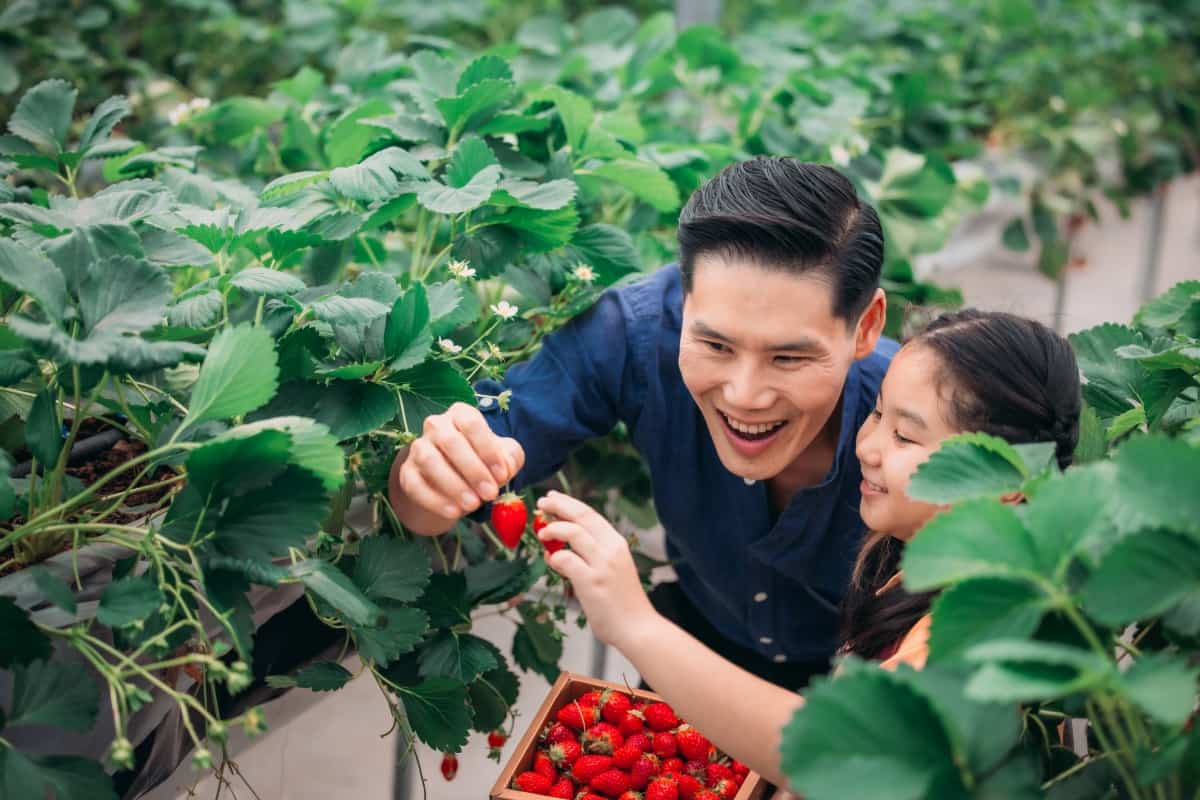
Planning and Preparation
Start by selecting the perfect location that receives ample sunlight and has well-drained soil. Conduct soil tests to determine its pH levels and nutrient content, ensuring it’s conducive to growing healthy strawberries. Next, invest in high-quality planting materials such as disease-free Strawberry plants from reputable nurseries. Selecting the right varieties suited to your climate and market demand is important for a successful harvest. Prepare all necessary tools and equipment ahead of time, including irrigation systems, trellises for support, and protective covers if needed.
Site Selection and Soil Preparation
Select a Strawberry planting location with full sun exposure to promote healthy growth. Ensure the soil is well-draining, fertile, and slightly acidic for optimal Strawberry production. Perform soil tests to determine its pH level and nutrient content. Make any necessary amendments, like adding compost or organic matter to improve soil structure. Consider factors like water availability and proximity to markets when selecting the site. Properly preparing the soil sets a strong foundation for your Strawberry plants’ growth and productivity.
Choosing Strawberry Varieties
Some popular varieties include Elsanta, known for its high yield and excellent flavor profile. Elvira is another favorite among farmers due to its disease resistance and easy maintenance. Evita is prized for its large fruit size and sweetness, making it a hit with consumers. Flamenco is a versatile variety that performs well in different climates, while Albion boasts exceptional shelf life and firmness.
In case you missed it: How to Control Pests and Diseases in Strawberry Crop: Causes, Symptoms, Chemical, and Biological Management
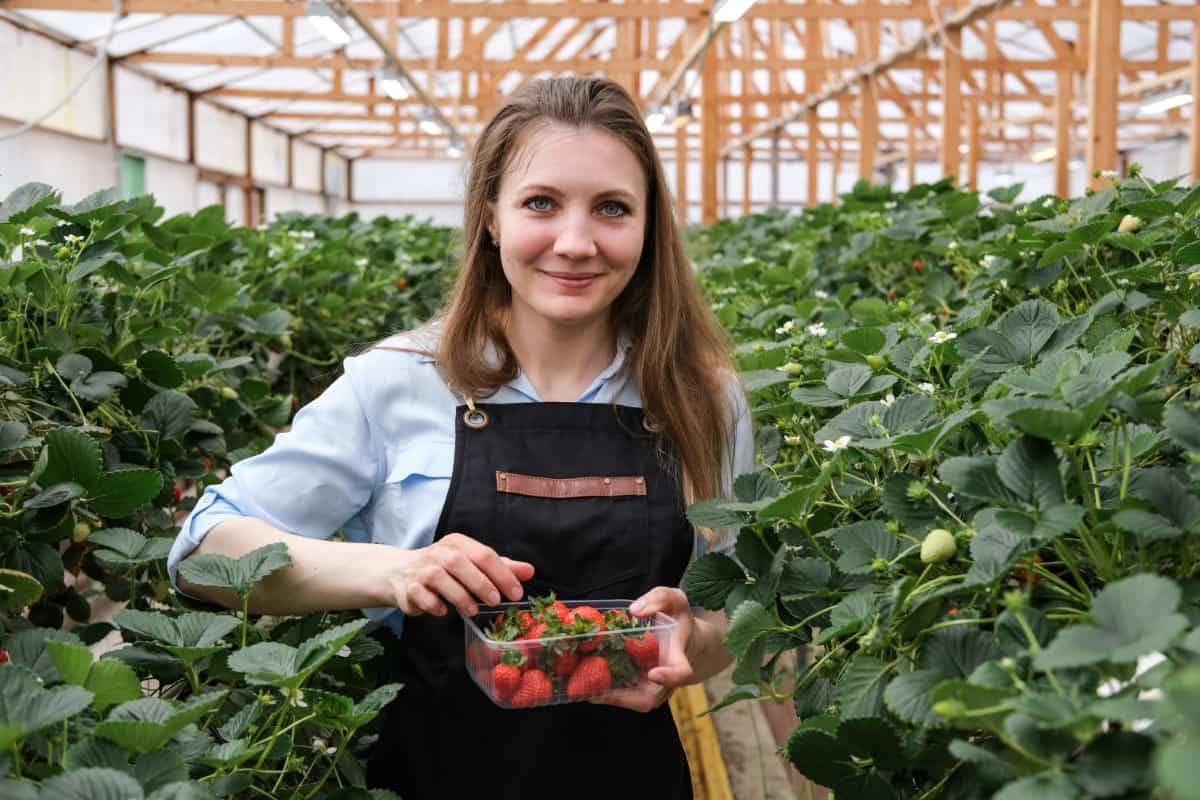
Cabot is known for its early ripening period, which allows farmers to start harvesting sooner in the season. Camarosa is famous for its vibrant red color and juicy texture, which appeal to customers. Cavendish offers excellent disease resistance and adaptability to various growing conditions. Honeoye, Earliglow, Ozark Beauty, Chandler, Jewel Seascape, and Tristar are also popular choices, each with unique qualities.
Planting Techniques and Timing
Ensure you plant your strawberries in well-drained soil with plenty of sunlight. Avoid waterlogged areas that can lead to root rot. Planting should ideally be done in early spring or late summer, depending on your location. Make sure to select healthy seedlings from a reputable source. Next, consider the spacing between each plant. It’s important to give your strawberries enough room to spread out and grow properly. Typically, plants should be spaced about 12 to 18 inches apart in planting rows that are about 2 to 3 feet apart.
Proper soil preparation is also essential for healthy Strawberry plants. The popular method is the hill system, where plants are spaced out in rows with mounded soil. Another technique is the matted row system, allowing strawberries to spread and form dense beds over time. For those looking for a more innovative approach, vertical gardening has gained traction in recent years.
Vertical gardening involves growing strawberries upwards on structures like trellises or hanging baskets, maximizing space and airflow for healthier plants. Additionally, hydroponic systems offer an alternative way to cultivate strawberries without soil by using nutrient-rich water solutions. Don’t forget to water thoroughly after planting and continue regular watering throughout the growing season to keep your Strawberry plants healthy and thriving.
Irrigation and Water Management
Irrigation plays a major role in ensuring healthy plant growth and maximum yield. Proper watering is important to keep the soil consistently moist but not waterlogged. Drip irrigation systems are commonly used in Strawberry fields to deliver water directly to the roots, minimizing wastage and promoting efficient utilization.
Monitoring soil moisture levels regularly is key to adjusting your watering schedule accordingly. Strawberry plants need 1 to 2 inches of water per week, depending on weather conditions and soil type. Mulching around strawberries helps retain moisture and reduce evaporation, especially during hot summer months.
Nutrient Management and Fertilization
Providing the right nutrients at the right time is essential for healthy plant growth and high-quality fruit production. Before planting, conduct soil tests to determine nutrient deficiencies and pH levels. Based on the results, create a fertilization plan tailored to your specific needs. Applying organic matter to the soil to improve nutrient retention. During the growing season, regularly monitor plant health and adjust fertilizer applications accordingly.
In case you missed it: How this Farmer Earning 18 Lakhs from His Strawberry Farm: A Success Story of a Fruit Farmer in India
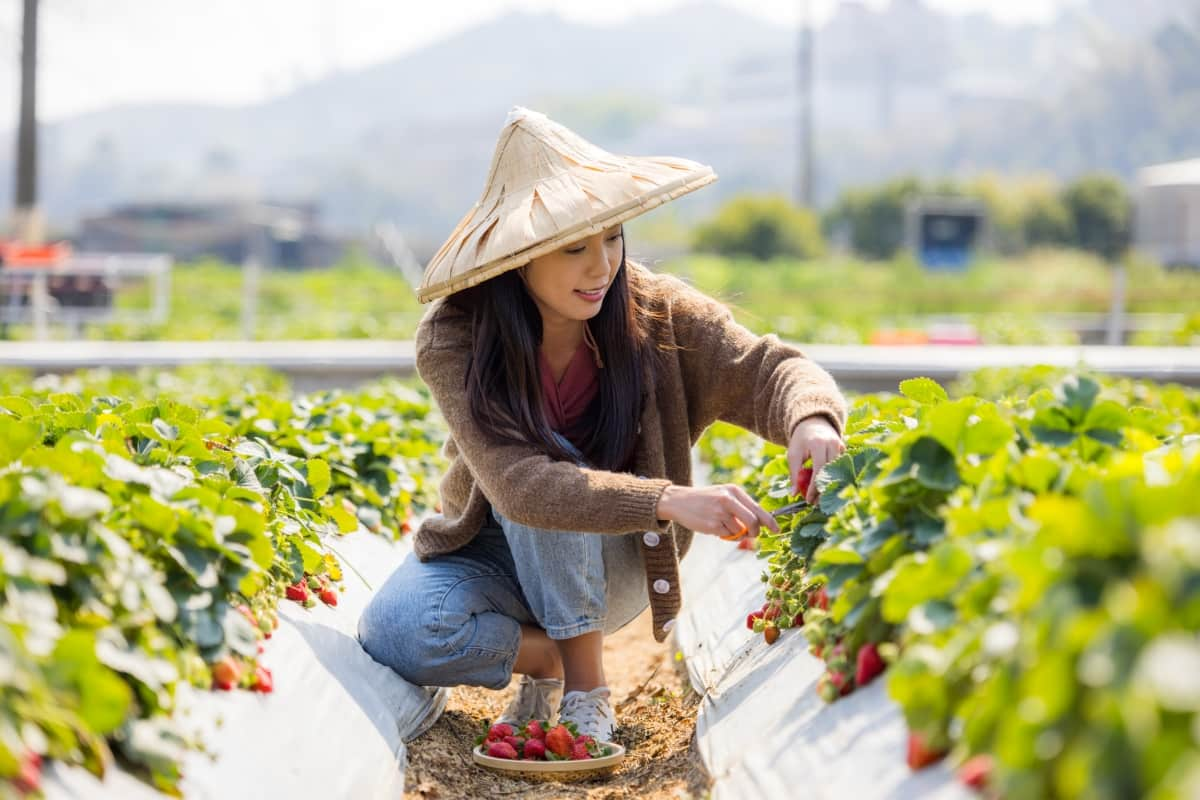
Balanced fertilizers rich in nitrogen, phosphorus, and potassium are key for vigorous growth and optimal fruit development. Avoid over-fertilizing the Strawberry plants, as it can lead to nutrient imbalances and environmental pollution. Consider using slow-release fertilizers or organic alternatives for sustainable nutrient management practices. Remember, providing adequate nutrition through proper fertilization is vital for maximizing yields and ensuring long-term success in your Strawberry farm.
Pest and Disease Control
It’s important to stay proactive in controlling these threats to ensure a healthy crop. Some common pests you may encounter include aphids, spider mites, and slugs, while diseases like powdery mildew and gray mold can also impact your strawberries. Implementing integrated pest management strategies is key to keeping these issues at bay.
This involves using a combination of cultural practices, biological controls, and chemical treatments. Utilizing beneficial insects, practicing crop rotation, and maintaining proper sanitation in your field are all effective ways to prevent pest and disease outbreaks. It is also essential to regularly inspect your Strawberry plants for any signs of infestation or disease.
Weed Management
Weeds compete with Strawberry plants for nutrients, water, and sunlight, which can significantly impact their growth and yield. To effectively manage weeds in your Strawberry farm, it is essential to implement cultural practices such as mulching to suppress weed growth. Additionally, hand weeding or using mechanical tools can help control weeds without harming the strawberries. Apply organic mulches like straw or black plastic mulch to suppress weed growth.
Remove weeds regularly by hand to prevent them from competing with the crop. Regular cultivation between rows helps to disturb weed growth and prevent them from establishing. Mulching with materials like straw, wood chips, or plastic can also suppress weed growth by blocking sunlight and preventing weed seeds from germinating. Rotating strawberries with other crops can help to disrupt weed life cycles and reduce weed pressure.
Apply cover crops during the off-season can also help to improve soil health. Regular monitoring of the farm for any signs of weed infestation is key to preventing them from taking over. Implementing a proactive approach to weed management will save you time and effort in the long run.
Mulching and Row Covers
Mulching helps to retain soil moisture and regulate soil temperature. It also reduces fruit rot by preventing direct contact between berries and the ground. Mulching involves covering the soil around Strawberry plants with an organic or synthetic material layer. Common materials used for mulching strawberries include straw, pine needles, shredded leaves, plastic mulch, or landscape fabric.
Using organic mulch like straw or pine needles can improve soil structure and increase earthworm activity, promoting healthier plants. Row covers act as a physical barrier against pests while creating a microclimate that accelerates plant growth. They are lightweight, breathable fabrics draped over rows of Strawberry plants. These covers can be made of materials like polypropylene.
In case you missed it: Growing Strawberries Vertically from Scratch: Methods, Tips, and Ideas
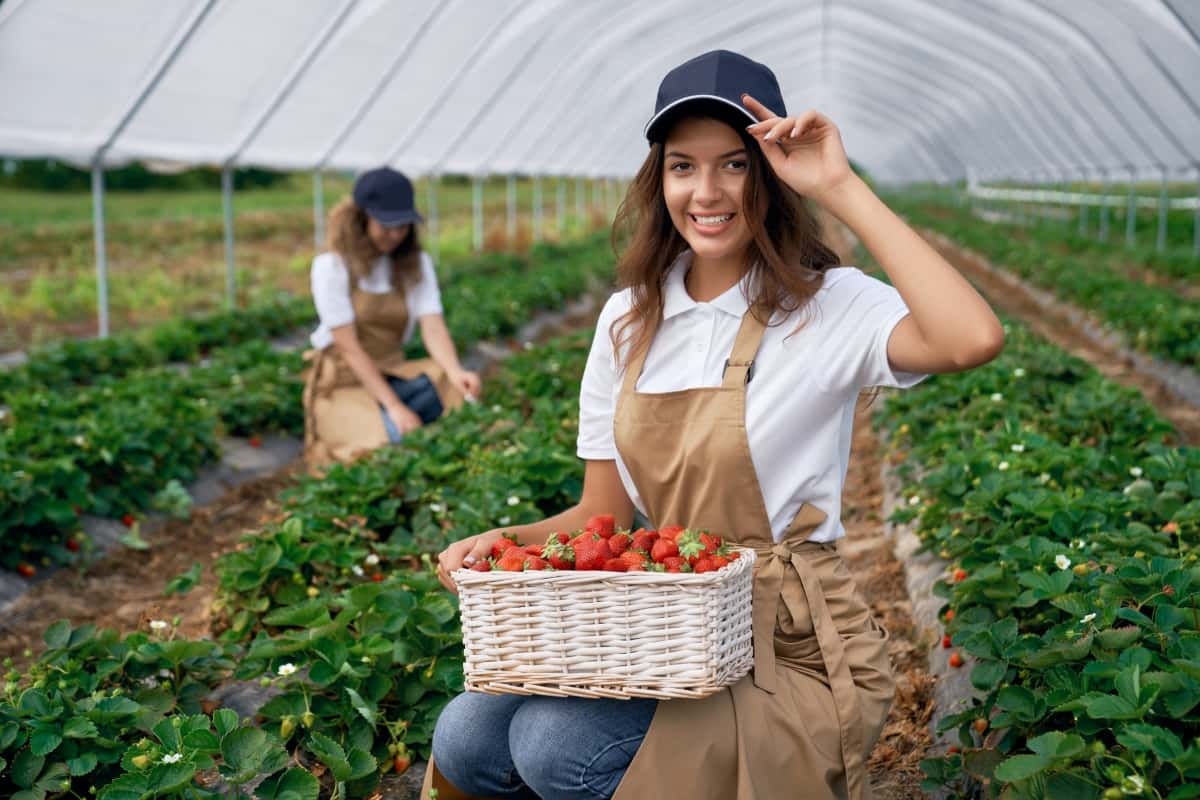
Row covers can reduce wind damage to plants by acting as a windbreak, preventing desiccation and physical damage to foliage. They can also be designed with openings or removed during flowering to allow bees and other insects to pollinate them. By covering rows with materials like floating row covers or plastic film, farmers can protect their crops to extend the growing season. This practice not only enhances yield but also minimizes the need for chemical pesticides.
Pruning and Runner Management
Pruning helps maintain plant health and productivity by removing old or diseased foliage. It also encourages new growth and improves air circulation within the plants, reducing the risk of diseases. Monitor your Strawberry plants for the formation of runners. Runners are long stems that emerge from the mother plant and produce new daughter plants at their nodes.
To propagate new plants, choose the healthiest and strongest runners. Look for runners with vigorous growth and well-developed roots. Proper pruning techniques involve cutting back excess runners and maintaining a compact plant structure. This process enhances fruit quality and simplifies harvesting by keeping the plants neat and organized.
When managing runners, it’s essential to control their spread to prevent overcrowding and ensure each plant receives adequate nutrients. By redirecting the runners or trimming them back, farmers can promote stronger root development and higher fruit yields. Effective runner management involves monitoring their growth regularly and taking timely action to prevent them from monopolizing space in the field.
Harvesting and Post-Harvest Handling
Harvesting strawberries is a rewarding task that requires careful attention to detail. When the fruits are ripe, it’s time to gently pluck them from the plants, being careful not to damage the delicate berries. Harvest strawberries when fully ripe, typically 4-6 weeks after flowering. Ripe berries will have a vibrant color and firm texture. Handle strawberries carefully to avoid bruising and damage, as they are delicate fruits.
In case you missed it: Top 20 Steps to Boost Strawberry Yield: How to Increase Strawberry Production
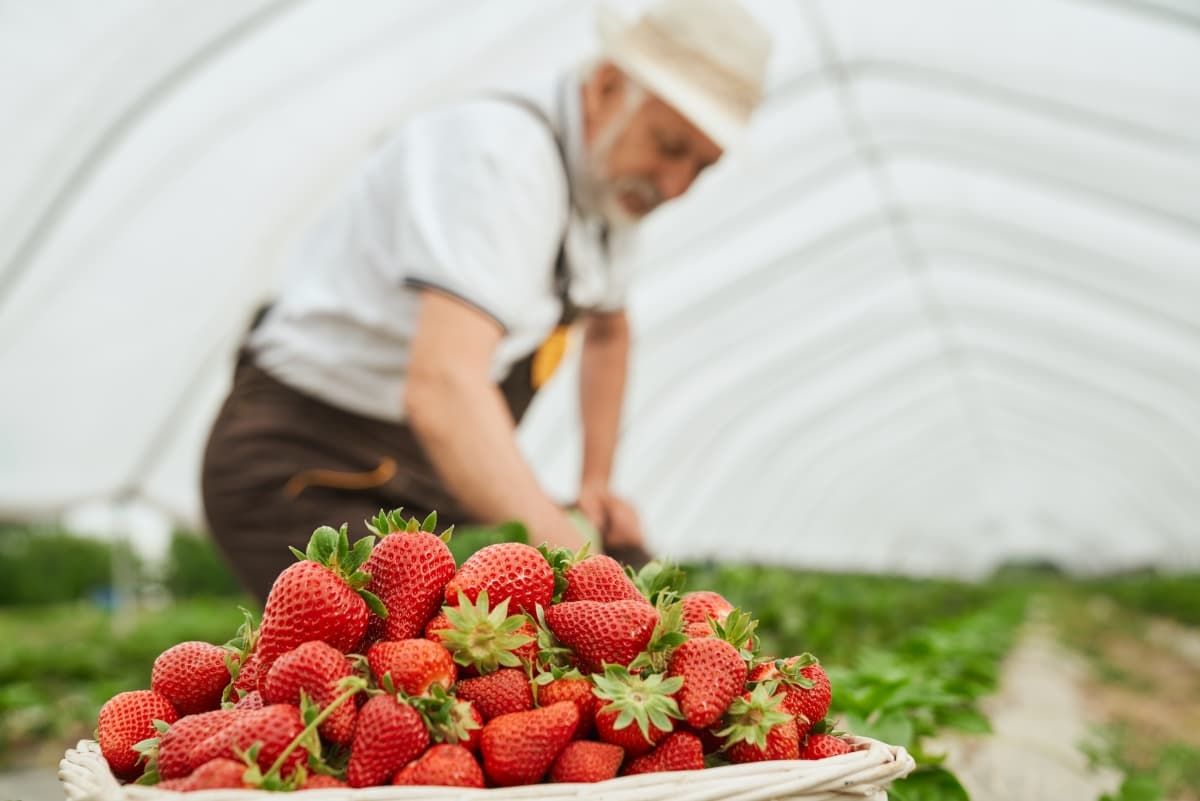
Post-harvest handling is important for maintaining the fruit quality and freshness. Proper storage in cool temperatures can help prolong their shelf life and preserve their flavor. Sorting through the harvested fruits ensures that only top-quality berries make it to market. Packaging plays a key role in presenting strawberries attractively to consumers. Whether they’re sold fresh at farmers’ markets or processed into jams and preserves, packaging should be eye-catching and informative.
Marketing and Sales Strategies
Utilize social media stages like Instagram and Facebook to showcase your fresh strawberries in all their vibrant red glory. Connect with local farmers’ markets or grocery stores to establish partnerships and expand your reach. Consider hosting pick-your-own Strawberry events on your farm to attract families looking for a fun weekend activity. Create eye-catching packaging for your strawberries that stands out on shelves and entices customers to choose yours over others.
Offer promotions such as discounts for bulk purchases for returning customers. Don’t underestimate the power of word-of-mouth marketing—encourage customers to spread the word about your delicious strawberries. Explore online sales opportunities through e-commerce platforms or delivery services to reach a wider audience beyond your local area.
Sustainability Practices in Strawberry Farming
Sustainability practices in Strawberry farming are crucial for ensuring the health of both the environment and the business. By implementing sustainable methods, farmers can reduce their environmental impact while also improving crop quality. The key practice is integrated pest management (IPM), which involves using natural predators and organic pesticides to control pests instead of harsh chemicals. This not only protects beneficial insects but also reduces chemical residues on strawberries.
In case you missed it: How To Start Strawberry Gardening, Tips, Ideas
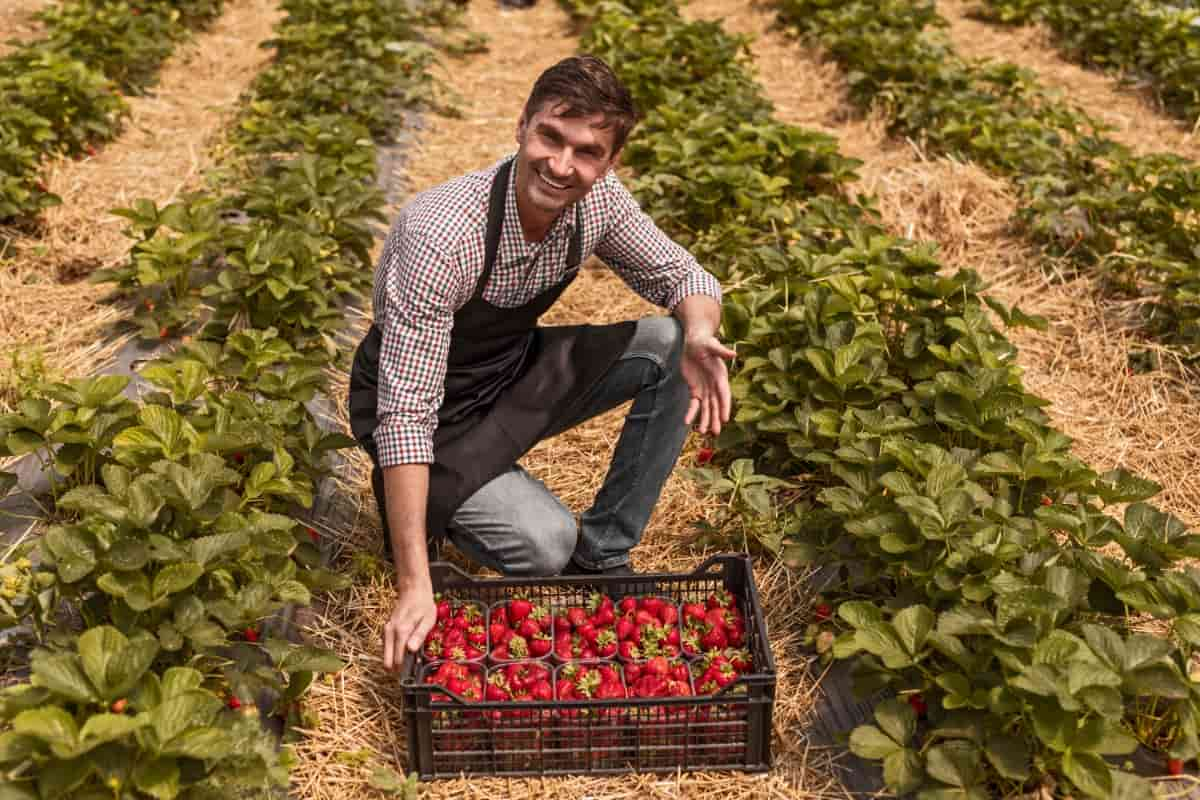
Drip irrigation systems help conserve water by delivering it directly to the plant root, minimizing waste, and promoting efficient water usage. Additionally, crop rotation can help prevent soil erosion and nutrient depletion, maintaining soil health for future seasons. Implementing cover cropping techniques naturally reduces weed pressure while adding organic matter back into the soil. These sustainable practices benefit the farm and contribute to a healthier ecosystem overall.
Technology and Innovation in Strawberry Production
With advancements in agricultural technology, Strawberry production has become more efficient and sustainable. The innovative practice is the use of precision agriculture techniques, such as drones and sensors, to monitor crop health and optimize irrigation. These tools help farmers make data-driven decisions to improve yield and quality. Additionally, vertical farming systems have gained popularity in Strawberry cultivation. By growing strawberries vertically in stacked layers, farmers can maximize space utilization while reducing water consumption.
Genetic engineering is important in developing new Strawberry varieties with improved resistance to plant pests and diseases, as well as enhanced flavor profiles. Furthermore, precision agriculture techniques such as soil sensors and GPS-guided machinery allow growers to tailor their farming practices according to specific field conditions. This level of customization not only enhances efficiency but also minimizes resource wastage, making Strawberry farming more sustainable in the long run.
Digital platforms enable farmers to track their production processes, manage inventory efficiently, and connect with buyers directly for streamlined sales transactions. Strawberry farming can be a lucrative and rewarding venture for beginners. Like any agricultural endeavor, it requires careful preparation to ensure success. It involves systematically cultivating these delicate fruits to ensure optimal growth and yield.
- Types of Pesticides Used in Agriculture: A Beginner’s Guide
- Economical Aquaculture: A Guide to Low-Budget Fish Farming
- 15 Common Planting Errors That Can Doom Your Fruit Trees
- How to Make Houseplants Bushy: Effective Tips and Ideas
- Innovative Strategies for Boosting Coconut Pollination and Yield
- Pollination Strategies for Maximum Pumpkin Yield
- The Complete Guide to Chicken Fattening: Strategies for Maximum Growth
- Natural Solutions for Tulip Problems: 100% Effective Remedies for Leaf and Bulb-Related Issues
- Revolutionizing Citrus Preservation: Towards a Healthier, Greener Future
- Natural Solutions for Peony Leaf and Flower Problems: 100% Effective Remedies
- Maximizing Profits with Avocado Contract Farming in India: A Comprehensive Guide
- Natural Solutions for Hydrangea Problems: 100% Effective Remedies for Leaf and Flowers
- The Ultimate Guide to Choosing the Perfect Foliage Friend: Bringing Life Indoors
- From Sunlight to Sustainability: 15 Ways to Use Solar Technology in Agriculture
- The Ultimate Guide to Dong Tao Chicken: Exploring from History to Raising
- The Eco-Friendly Makeover: How to Convert Your Unused Swimming Pool into a Fish Pond
- Mastering the Art of Delaware Chicken Farming: Essentials for Healthy Backyard Flocks
- 20 Best Homemade Fertilizers for Money Plant: DIY Recipes and Application Methods
- How to Craft a Comprehensive Free-Range Chicken Farming Business Plan
- Brighten Your Flock: Raising Easter Egger Chickens for Beauty and Bounty
- How to Optimize Your Poultry Egg Farm Business Plan with These Strategies
- Subsidy for Spirulina Cultivation: How Indian Government Schemes Encouraging Spirulina Farmers
- Ultimate Guide to Raising Dominique Chickens: Breeding, Feeding, Egg-Production, and Care
- Mastering the Art of Raising Jersey Giant Chickens: Care, Feeding, and More
- Ultimate Guide to Raising Legbar Chickens: Breeding, Farming Practices, Diet, Egg-Production
- How to Raise Welsummer Chickens: A Comprehensive Guide for Beginners
- How to Protect Indoor Plants in Winter: A Comprehensive Guide
- Ultimate Guide to Grow Bag Gardening: Tips, Tricks, and Planting Ideas for Urban Gardeners
- Guide to Lotus Cultivation: How to Propagate, Plant, Grow, Care, Cost, and Profit
- Agriculture Drone Subsidy Scheme: Government Kisan Subsidy, License, and How to Apply Online
- Ultimate Guide to Raising Araucana Chickens: Breed Profile, Farming Economics, Diet, and Care
- Bringing Hydroponics to Classroom: Importance, Benefits of Learning for School Students
- Ultimate Guide to Raising Polish Chickens: Breed Profile, Farming Economics, Diet, and Care
- Ultimate Guide to Raising Australorp Chickens: Profile, Farming Economics, Egg Production, Diet, and Care
- Silkie Chicken Farming: Raising Practices, Varieties, Egg Production, Diet, and Care
- Sussex Chicken Farming: Raising Practices, Varieties, Egg Production, Diet and Care
Laxmi Strawberry Farm, the place to be all year round and especially at strawberry season!!! Come and spend the day picking and eating ripe organic strawberries, down in our fields!.
Please provide me the location to visit you
I also am a strawberry planter . Very interesting article for me . New ideas, but nothing on bio farming . I am concentrating in planting my favorite fruit strawberry using bio technology. I from Mauritius .
Thanks
We will update about the bio-cultivation soon.
Thanks for the article. I want to start the strawberry farm which I like most.
I am inviting you to visit my farm in Mauritius
Thankyou so much for everything. Each and every fruit are so nice and beautiful.
Thank you so much information i would like to learn more. i am will to start a strawberry farm,in botswana,any help will be much appreciated
Hi Team,This is Ashishdayal as am interested in cultivating starwberry and am eagerly waiting to visit the farm and learn how do we cultivate starwberry.Can someone help me.
Thank you, have read through, it was helpful
If any help regarding Strawberry cultivation I will provide.
where is your farm located and what’s the actual profit per season in strawberry farming ?,
I am thinking about starting one and want to analyze various options of crops and plants that I can grow for maximum profits in chhattisgarh !!
Any help or suggestions is much appreciated !
How much strawberry could be grown in an acre of land and how much does it cost to grow. Can it be grown near by Bareilly area?